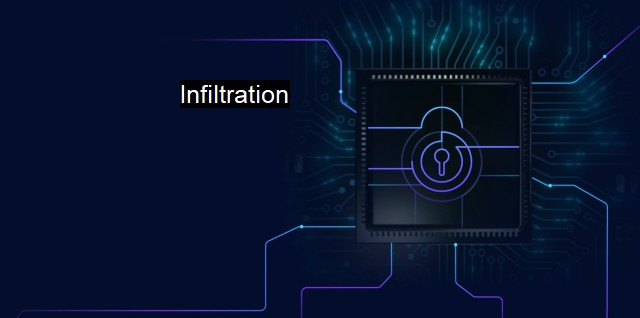What is Infiltration?
Exploring the Threat of Infiltration in Cybersecurity: Importance of Antivirus Solutions in Safeguarding Networks.
Infiltration refers to the act of secretly entering, observing, or extracting sensitive information from a secure system or network. This is typically the objective of cybercriminals or hackers who aim to penetrate protective barriers installed on systems in a bid to scrape sensitive information, corrupt data, disrupt operations, or deliver a damaging payload such as a virus.The modern digital world's continuous advancement provides an increasingly wall-to-wall environment constantly open to threats. It's against this background that the ominous reality of infiltration resides, a creeping terror that violates system defenses to deploy sometimes irreversible and devastating tactics.
The severity of infiltration could be widely spread from simple password guessing to the exploitation of complex system vulnerabilities barely obvious to even an experienced eye. A common form of infiltration is phishing, widely utilized by cybercriminals to trick users into revealing passwords, credit card numbers, and other sensitive details. Here, seemingly innocuous emails, forged to appear to have originated from a trusted source, are sent to potential victims, drawing them into a trap that prompts the sharing of sensitive information.
Another prevalent method is through SQL injection attacks against web-based applications. Cybercriminals misuse standard data interactivity functionalities to feed malicious commands into a system's database, tricking the system into allowing unauthorized access or using the information in the database against the system.
Malware infiltration, on the other hand, involves a harmful application or software being secretly installed onto the user's system. This infiltrating software can record keystrokes, gain unauthorized access to systems files, and generally wreak havoc on the system – often unbeknownst to the user.
In the arms race of cyber infiltration, antivirus software plays a crucial protective and frontline role. Antiviruses are specialized programs designed to prevent, detect, and remove malicious software from a computer system. They operate primarily based on a database of known virus signatures and make use of heuristic analysis to identify new or modified versions of known viruses.
Detecting an infiltration depends essentially on the capabilities of the antivirus software in question. A good antivirus must constantly update its database to include new malware and virus signatures and be aggressive enough to delve deep into the system to catch out any hidden footprints of an infiltration.
Ensuring your antivirus is always kept up to date has its advantages. Hackers are constantly improving and changing their strategies, trying to have an edge over antivirus interfaces. Software companies counteract this by releasing regular updates to improve and add new defenses to their products, including antivirus.
To mitigate the damage caused by infiltration, consider implementing an Intrusion Detection System (IDS). Similar to an alarm system, IDS identifies any anomalous activities that may suggest infiltration. many IDS provide an Intrusion Prevention System (IPS) which automatically puts a stop to suspicious activity once detected, providing an onsite countermeasure to digital incursion.
An effective cybersecurity strategy goes beyond antivirus software. It may entail rigorous firewall configurations, secure system admin practices, regular software updates, comprehensive user education on cyber threats, and the use of robust, regularly changed passwords alongside secure user authentication protocols. An optimal mix of these measures makes it as hard as possible for any malicious actor to gain unhindered access.
Infiltration in cybersecurity is a formidable challenge that constantly evolves, finding new ways to subvert our defenses. Responding to it requires continuous evolution on our part. Cases of infiltration underline the increasingly dire need for robust, dynamic antivirus systems working in harmony with broad holistic practices, user vigilance, and awareness for successful mitigation. Make infiltration difficult for cybercriminals, and quadruple their work by putting your defenses as high as possible using joint strategies and up-to-date systems.

Infiltration FAQs
What is infiltration in cybersecurity?
Infiltration in cybersecurity refers to a malicious attack or breach that involves gaining unauthorized access to a computer network, system, or application.How do cyber attackers infiltrate a system?
Cyber attackers infiltrate a system by exploiting vulnerabilities in the software, hardware, or human error such as phishing scams, social engineering tactics, and weak passwords.What are the consequences of infiltration?
Infiltration could lead to data theft, financial loss, system crashes, and damage to a company's reputation. It could also result in identity theft, ransomware attacks, and loss of business continuity.How can antiviruses prevent infiltration?
Antiviruses can prevent infiltration by detecting and removing malware, blocking suspicious websites, and monitoring network traffic. They also provide regular software updates and patch vulnerabilities to prevent attacks. Adopting good security practices like strong passwords, regular backups, and employee training can also help prevent infiltration.| | A | | | B | | | C | | | D | | | E | | | F | | | G | | | H | | | I | | | J | | | K | | | L | | | M | |
| | N | | | O | | | P | | | Q | | | R | | | S | | | T | | | U | | | V | | | W | | | X | | | Y | | | Z | |
| | 1 | | | 2 | | | 3 | | | 4 | | | 7 | | | 8 | | |||||||